
Detective fiction is a subgenre of crime fiction and mystery fiction in which an investigator or a detective—whether professional, amateur or retired—investigates a crime, often murder. The detective genre began around the same time as speculative fiction and other genre fiction in the mid-nineteenth century and has remained extremely popular, particularly in novels. Some of the most famous heroes of detective fiction include C. Auguste Dupin, Sherlock Holmes, and Hercule Poirot. Juvenile stories featuring The Hardy Boys, Nancy Drew, and The Boxcar Children have also remained in print for several decades.

A whodunit or whodunnit is a complex plot-driven variety of detective fiction in which the puzzle regarding who committed the crime is the main focus. The reader or viewer is provided with the clues to the case, from which the identity of the perpetrator may be deduced before the story provides the revelation itself at its climax. The investigation is usually conducted by an eccentric, amateur, or semi-professional detective.

Crime fiction, detective story, murder mystery, mystery novel, and police novel are terms used to describe narratives that centre on criminal acts and especially on the investigation, either by an amateur or a professional detective, of a crime, often a murder. It is usually distinguished from mainstream fiction and other genres such as historical fiction or science fiction, but the boundaries are indistinct. Crime fiction has multiple subgenres, including detective fiction, courtroom drama, hard-boiled fiction, and legal thrillers. Most crime drama focuses on crime investigation and does not feature the courtroom. Suspense and mystery are key elements that are nearly ubiquitous to the genre.
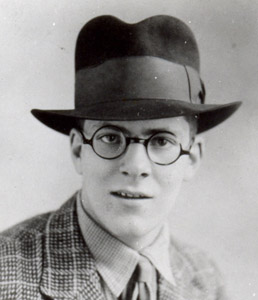
Ruthven Campbell Todd was a Scottish poet, artist and novelist, best known as an editor of the works of William Blake, and expert on his printing techniques. During the 1940s he also wrote detective fiction under the pseudonym R. T. Campbell and children's fiction during the 1950s.
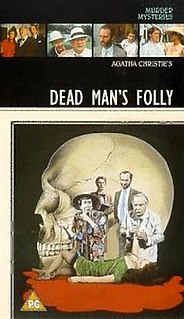
Dead Man's Folly is a 1986 British-American made-for-television mystery film featuring Agatha Christie's Belgian detective Hercule Poirot. It is based on Christie's 1956 novel Dead Man's Folly. The film was directed by Clive Donner and starred Peter Ustinov as Poirot.

Spotted Hemlock is a 1958 mystery detective novel by the British writer Gladys Mitchell. It is the thirty first in the long-running series of books featuring Mitchell's best known creation, the psychoanalyst and amateur detective Mrs Bradley. It has been considered one of Mitchell's best novels along with other works such as The Saltmarsh Murders, Death at the Opera and The Rising of the Moon.

Laurels are Poison is a 1942 mystery detective novel by the British writer Gladys Mitchell. It is the fourteenth in her long-running series featuring the psychoanalyst and amateur detective Mrs Bradley. It was Mitchell's own favourite among her novels and has been considered her best by other critics. It introduced the character of Laura Menzies who became recurring assistant of Mrs Bradley in subsequent novels.
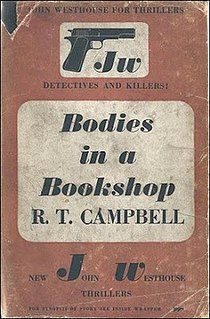
Bodies in a Bookshop is a 1946 mystery detective novel by the British author Ruthven Todd, written under the pen name of R.T. Campbell. It was one of several novels featuring the botanist and amateur detective Professor John Stubbs.

The Death Cap is a 1946 mystery detective novel by the British author Ruthven Todd, written under the pen name of R.T. Campbell. It was one of several novels featuring the botanist and amateur detective Professor John Stubbs.
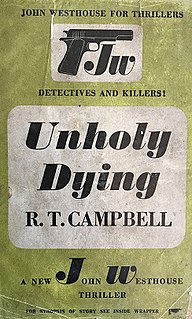
Unholy Dying is a 1945 mystery detective novel by the British author Ruthven Todd, written under the pen name of R.T. Campbell. It was the first in a series of novels featuring the botanist and amateur detective Professor John Stubbs. It has been republished in 1985 and 2019 by Dover Publications.

Swing Low, Swing Death is a 1946 mystery detective novel by the British author Ruthven Todd, written under the pen name of R.T. Campbell. It was the last of seven novels featuring the botanist and amateur detective Professor John Stubbs. Todd planned to continue the series, with five more titles announced, but the bankruptcy of his publisher brought the series to a halt. The following year he emigrated to the United States. It was republished in 2018 by Dover Publications, along with three others Stubbs adventures.

The Sea Mystery is a 1928 detective novel by Freeman Wills Crofts. It is the fourth in a series of novels featuring Inspector French of Scotland Yard. As with a number of his works Crofts creates a puzzling mystery which French is then able to solve using a Tide table and Bradshaw's Guide to the railways. The plot has some similarities with his debut novel The Cask (1920).

The Mystery of Number 47 is a 1912 comedy mystery thriller novel by the British writer J. Storer Clouston. Living in a quiet suburb of London and writing detective novels under an assumed name, Irwin Molyneux is suddenly drawn into a real-life case when he is sought by Scotland Yard for the murder of his wife due to a series of misunderstandings. It was originally published in London by Mills & Boon under the title His First Offence.
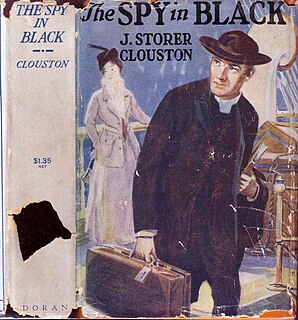
The Spy in Black is a 1917 spy thriller novel by the British writer J. Storer Clouston. It takes place near Scapa Flow in the Orkneys during the First World War. It was one of several thrillers he wrote along with The Man from the Clouds and Beastmark the Spy.
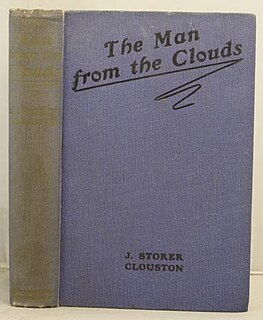
The Man from the Clouds is a 1918 spy thriller novel by J. Storer Clouston. Like his better-known The Spy in Black it takes place during the First World War.

Fell Murder is a 1944 detective novel by E.C.R. Lorac, the pen name of the British writer Edith Caroline Rivett. It was the twenty fourth novel of her long-running series featuring Chief Inspector MacDonald of Scotland Yard. Originally published by Collins Crime Club, it was reissued in 2019 by the British Library Publishing as part of a group of crime novels from the Golden Age of Detective Fiction.

In Face of the Verdict is a 1936 detective novel by John Rhode, the pen name of the British writer Cecil Street. It is the twenty fourth in his long-running series of novels featuring Lancelot Priestley, a Golden Age armchair detective. Unusually in the series Priestley takes a more active role in the investigation himself, rather than solving it from a detached distance. It was not published in the United States until 1940, by Dodd Mead, with the slightly altered title of In the Face of the Verdict.

Invisible Weapons is a 1938 detective novel by John Rhode, the pen name of the British writer Cecil Street. It is the twenty eighth in his long-running series of novels featuring Lancelot Priestley, a Golden Age armchair detective. A locked room mystery, the title revolves around the fact that two murders are committed by apparently invisible methods.
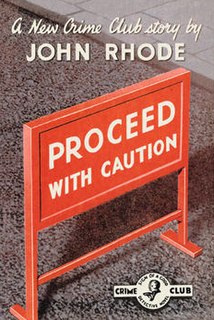
Proceed with Caution is a 1937 detective novel by John Rhode, the pen name of the British writer Cecil Street. It is the twenty seventh in his long-running series of novels featuring Lancelot Priestley, a Golden Age armchair detective. It was published in the United States the same year by Dodd Mead under the alternative title Body Unidentified.


















